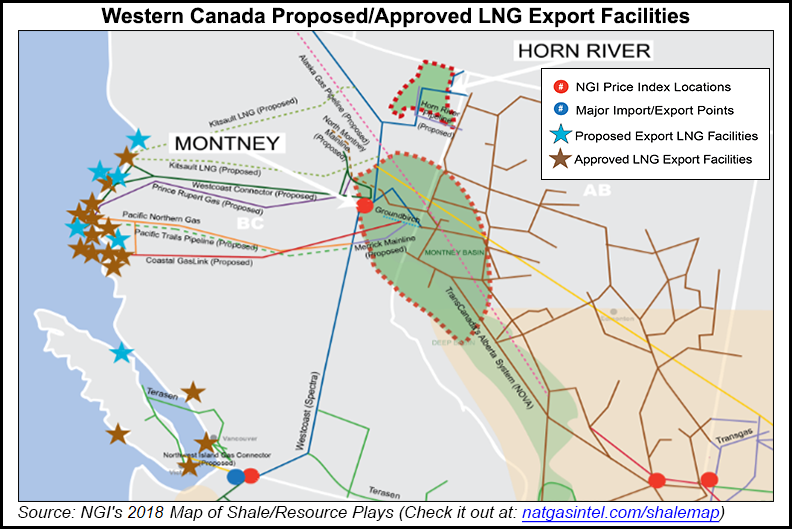Infrastructure | LNG | NGI All News Access | NGI The Weekly Gas Market Report
TransCanada Lines Up Construction Contracts for Coastal GasLink Pipe, Awaits LNG Canada FID
After a five-year wait, TransCanada Corp. primed itself Tuesday for a quick start on building a supply pipeline for natural gas exports from the northern Pacific coast of British Columbia (BC).

TransCanada’s Coastal GasLink project announced four construction contracts for work to start on its cross-BC route for the massive liquefied natural gas (LNG) project as soon as LNG Canada makes a final investment decision (FID) to go ahead with its proposed terminal at Kitimat.
The BC government has set a November deadline for the export consortium led by a unit of Royal Dutch Shell plc with partners Petronas, Mitsubishi Corp. and Korea Gas Corp., to accept an incentive offer of C$6 billion ($4.8 billion) in provincial income, sales and carbon tax cuts.
The status of LNG Canada’s C$14 billion ($11 billion) terminal proposal remains unchanged, under review with consortium leader Shell Canada Ltd. said to be “cautiously optimistic” about a “quite bullish” overseas market outlook.
The new construction contracts for Coastal GasLink cover C$2.8 billion ($2.2 billion) of challenging work laying 670 kilometers (416 miles) of pipe across forests, muskeg swamps and mountains from northern BC’s shale and tight gas production fields.
The contractors form a team of veteran BC and international pipeline construction firms: Surerus Murphy Joint Venture, SA Energy Group, Macro Spiecapag Joint Venture and Pacific Atlantic Pipeline Construction Inc.
LNG Canada has held an export license for up to 3.7 Bcf/d from the National Energy Board (NEB) since February 2013. The original 25-year term has been increased to 40 years, and the deadline for starting shipments has been extended for five years until the end of 2027.
Coastal GasLink evolved under an agreement between TransCanada and LNG Canada, obtaining environmental approval in October 2014 and construction permits in April 2016. TransCanada shelved a parallel, planned and approved cross-BC gas conduit last year after the proposed customer, Pacific NorthWest LNG led by Petronas, scrapped plans for an export terminal at Prince Rupert, north of LNG Canada’s Kitimat location.
© 2024 Natural Gas Intelligence. All rights reserved.
ISSN © 1532-1231 | ISSN © 2577-9877 | ISSN © 1532-1266 |
